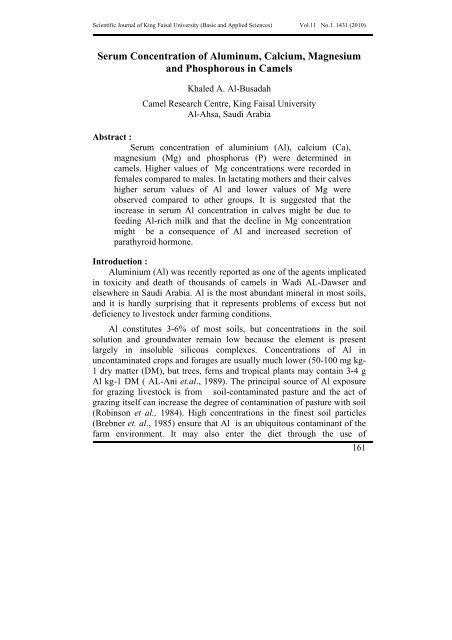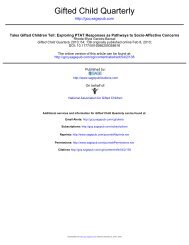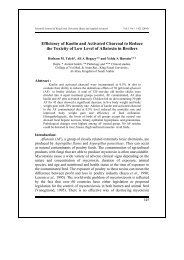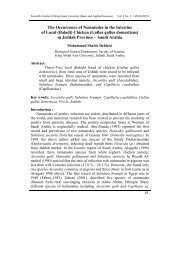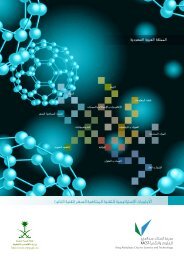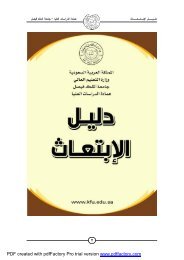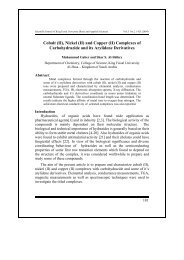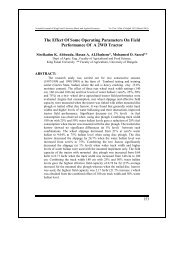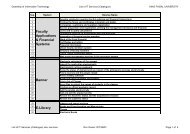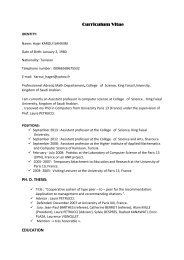Serum Concentration of Aluminum, Calcium, Magnesium and ...
Serum Concentration of Aluminum, Calcium, Magnesium and ...
Serum Concentration of Aluminum, Calcium, Magnesium and ...
Create successful ePaper yourself
Turn your PDF publications into a flip-book with our unique Google optimized e-Paper software.
Scientific Journal <strong>of</strong> King Faisal University (Basic <strong>and</strong> Applied Sciences) Vol.11 No.1 1431 (2010)<strong>Serum</strong> <strong>Concentration</strong> <strong>of</strong> <strong>Aluminum</strong>, <strong>Calcium</strong>, <strong>Magnesium</strong><strong>and</strong> Phosphorous in CamelsKhaled A. Al-BusadahCamel Research Centre, King Faisal UniversityAl-Ahsa, Saudi ArabiaAbstract :<strong>Serum</strong> concentration <strong>of</strong> aluminium (Al), calcium (Ca),magnesium (Mg) <strong>and</strong> phosphorus (P) were determined incamels. Higher values <strong>of</strong> Mg concentrations were recorded infemales compared to males. In lactating mothers <strong>and</strong> their calveshigher serum values <strong>of</strong> Al <strong>and</strong> lower values <strong>of</strong> Mg wereobserved compared to other groups. It is suggested that theincrease in serum Al concentration in calves might be due t<strong>of</strong>eeding Al-rich milk <strong>and</strong> that the decline in Mg concentrationmight be a consequence <strong>of</strong> Al <strong>and</strong> increased secretion <strong>of</strong>parathyroid hormone.Introduction :Aluminium (Al) was recently reported as one <strong>of</strong> the agents implicatedin toxicity <strong>and</strong> death <strong>of</strong> thous<strong>and</strong>s <strong>of</strong> camels in Wadi AL-Dawser <strong>and</strong>elsewhere in Saudi Arabia. Al is the most abundant mineral in most soils,<strong>and</strong> it is hardly surprising that it represents problems <strong>of</strong> excess but notdeficiency to livestock under farming conditions.Al constitutes 3-6% <strong>of</strong> most soils, but concentrations in the soilsolution <strong>and</strong> groundwater remain low because the element is presentlargely in insoluble silicous complexes. <strong>Concentration</strong>s <strong>of</strong> Al inuncontaminated crops <strong>and</strong> forages are usually much lower (50-100 mg kg-1 dry matter (DM), but trees, ferns <strong>and</strong> tropical plants may contain 3-4 gAl kg-1 DM ( AL-Ani et.al., 1989). The principal source <strong>of</strong> Al exposurefor grazing livestock is from soil-contaminated pasture <strong>and</strong> the act <strong>of</strong>grazing itself can increase the degree <strong>of</strong> contamination <strong>of</strong> pasture with soil(Robinson et al., 1984). High concentrations in the finest soil particles(Brebner et. al., 1985) ensure that Al is an ubiquitous contaminant <strong>of</strong> thefarm environment. It may also enter the diet through the use <strong>of</strong>161
<strong>Serum</strong> <strong>Concentration</strong> <strong>of</strong> <strong>Aluminum</strong>, <strong>Calcium</strong>, …Khaled A. Al-Busadahcontaminated mineral supplements (e.g. s<strong>of</strong>t phosphate, 70 g Al kg-1 DM), feed-pelleting agents, such as bentonite (110 g Al kg-1 DM), or aids todigestion; such as zeolite (60 g Al kg-1 DM) ( Bishop, 2005).The determination <strong>of</strong> some trace minerals <strong>and</strong> their interactions isessential to underst<strong>and</strong> their physiological role. Therefore, this study wasdesigned to determine serum concentration <strong>of</strong> Al, calcium( Ca),magnesium( Mg) <strong>and</strong> phosphorous ( P) in the serum <strong>of</strong> camels.Material <strong>and</strong> Methods :Blood samples were collected from 14 adult male <strong>and</strong> 18 adult, nonpregnant,non-lactating female camels, aged 4-5 years old, in addition to19 lactating female camels <strong>and</strong> their calves <strong>and</strong> 13 pregnant femalecamels. The blood was collected by venipuncture into clean plain siliconcoated vacutainer tubes <strong>and</strong> the separated sera were kept frozen at 4˚Cuntil analyzed.<strong>Serum</strong> Al, Ca <strong>and</strong> Mg concentrations were measured using atomicabsorption spectroscopy (Pye-Unicam SP 90, spectrophotometer, UnicamInstruments Ltd., Cambridge, Engl<strong>and</strong>) equipped with an air acetyleneflame. The st<strong>and</strong>ards <strong>and</strong> samples were prepared in 0.78% ethylenediamine tetra-acetic acid ( EDTA) solutions to reduce phosphateinterference.<strong>Serum</strong> inorganic phosphorus (P) was measured according to themethod <strong>of</strong> Varley (1967). The principle <strong>of</strong> the method is based on thereaction <strong>of</strong> the phosphate to form a coloured complex with molybdate <strong>and</strong>v<strong>and</strong>ate in the presence <strong>of</strong> nitric acid.Statistical analysis :The results <strong>of</strong> serum Al, Ca, Mg <strong>and</strong> P concentrations in adult <strong>and</strong>young calf camels were statistically analyzed according to Gomez <strong>and</strong>Gomez, (1984) using the analysis <strong>of</strong> variance (ANOVA) procedure.162
Scientific Journal <strong>of</strong> King Faisal University (Basic <strong>and</strong> Applied Sciences) Vol.11 No.1 1431 (2010)Result <strong>and</strong> discussion :Result <strong>of</strong> mineral concentations are given in Table 1. Most <strong>of</strong> theresults <strong>of</strong> mineral levels for male <strong>and</strong> female camels were comparablewith previous studies (Abdalla et. al., 1988, Wernery et. al., 1999, Osman<strong>and</strong> Al-Busadah 2003, Barri et. al., 2005, Faye et al. 2005, Mohammed et.al., 2007).Table ( 1 )mean ± SD serum mineral concentrations in camelsGroups(n)Al(mg/100ml)Mg(mg/dl)Ca(mg/dl)P(mg/dl)Males (14) 2.2 ± 0.32 a 4.61 ± 0.22 a 9.3 ± 0.51 a 6.14 ± 0.45 aFemales (18) 4.4 ± 0.41 b 3.7 ± 0.2 a 10.11± 0.62 a 6.21 ± 0.50 aPregnant (13) 5.6 ± 0.52 b 3.6 ± 0.40 a 10.12 ± 0.53 a 6.1 ± 0.55 aLactating (19) 10.11 ± 1.2 c 1.6 ± 0.12 b 11.4 ± 0.32 a 6.2± 0.51 aCalves (19) 6.1 ± 0.50 d 2.1 ± 0.14 b 12.4 ± 0.30 b 7.1 ± 0.56 aa,b,c,d means with different superscripts in the same column are significantly differentat P< 0.05.Gender <strong>and</strong> physiological status seemed to affect the individualmineral concentration. Higher values <strong>of</strong> serum Al <strong>and</strong> Ca <strong>and</strong> lower values<strong>of</strong> Mg concentration were observed in female compared to male camels.Similar results were reported elsewhere (Faye et.al., 2005). Lactatingmothers <strong>and</strong> their calves had significantly (P < 0.05) higher serum Alconcentration than other groups. It is unlikely that the source <strong>of</strong> Al in theseanimals was from soil, since soil forms <strong>of</strong> Al are <strong>of</strong> low solubility atneutral pH as would be found in the rumen ( Allen et. al., 1986). Theavailability <strong>of</strong> Al from shrubs <strong>and</strong> parts <strong>of</strong> plants eaten by the camel meritsfurther investigation. For the calves, the high level <strong>of</strong> serum Al is difficultto explain. However, milk could be the source. Different breed <strong>of</strong> camelshave different capacities to deposit minerals in their milk (Wangoh et. al.,1998, Mal et. al., 2007). In lactating animals, a dramatic decline in serumMg concentration was noted. Elevated level <strong>of</strong> parathyroid hormone(PTH) might also be associated with increased Al absorption (Mayor et.al., 1977). In the present study lactating camels were likely to haveelevated PTH due to their early stage <strong>of</strong> lactation. The decline in serumMg could be a consequence <strong>of</strong> Al elevation in the serum. Al dosing <strong>of</strong>163
<strong>Serum</strong> <strong>Concentration</strong> <strong>of</strong> <strong>Aluminum</strong>, <strong>Calcium</strong>, …Khaled A. Al-Busadahsteers, sheep <strong>and</strong> cows ( Allen <strong>and</strong> Fontenot 1984) was shown to induceddepressed serum Mg.The present results show that serum Ca was higher in calvescompared to others. Ca <strong>and</strong> Mg ions are transferred from mother to foetusagainst concentration gradients, presumably reflecting active transportmechanism for both cations by the placenta, with the result that the foetusat birth is rendered hypercalcaemic <strong>and</strong> hypomagnesaemic in relation to itsmother ( Care et. al., 1982 <strong>and</strong> Barri et. al., 2005). These featurescontinued to be seen in early neonates probably as a result <strong>of</strong> feeding Alcontainingmilk.164
Scientific Journal <strong>of</strong> King Faisal University (Basic <strong>and</strong> Applied Sciences) Vol.11 No.1 1431 (2010)References :1. AL-Ani, F; Husayni, H.A <strong>and</strong> Power (1988). A comperhensive biochemicalanalysis <strong>of</strong> the blood <strong>of</strong> the camel. Comparative Biochem. Physiol. 89B, 35-37.2. Abdalla O. M. Wasfi I. W. <strong>and</strong> Gadir F. A. (1988). The Arabian race camelnormal parameters. 1. Haemogram, enzymes <strong>and</strong> minerals. ComparativeBiochemical <strong>and</strong> Physiological 90: 237-239.3. Allen V. G. <strong>and</strong> Fontenot J. P. (1984). Influence <strong>of</strong> aluminum as sulfate,chloride <strong>and</strong> citrate on magnesium <strong>and</strong> calcium metabolism in sheep.Journal <strong>of</strong> Animal Sciences 59: 798.4. Barri M. E.S. Al- Busadah K. A. <strong>and</strong> Homeida A. M. (2005). Comparativecalcium <strong>and</strong> magnesium status in adult <strong>and</strong> young camels. Scientific Journal<strong>of</strong> King Faisal University 6, 151-158.5. Bishop Y. (2005). The veterinary formulary. Pharmaceutical Press, London,UK.6. Bogden, J.D., Thind, I.S., Kemp, F.W. <strong>and</strong> Catorini, H.(1978). Plasmaconcentration <strong>of</strong> calcium, chromium, copper, iron, magnesium <strong>and</strong> zinc inmaternal <strong>and</strong> cord blood <strong>and</strong> their relationship to low birth weight. Journal<strong>of</strong> Laboratory <strong>and</strong> Clinical Medicine 92,455-462.7. Brebner, J., Thornton, I., McDonald, P. <strong>and</strong> Suttle. N.F. (1985). The release<strong>of</strong> trace elements from soils under conditions <strong>of</strong> simulated rumenal <strong>and</strong>abomasal digestion. In: Mills, C.F., Bremner, I. <strong>and</strong> Chesters, J.K. (eds)Proceedings <strong>of</strong> the Fifth International Symposium on Trace Elements inAnimals <strong>and</strong> Man. Commonwealth Agricultural Bureaux, Farnham Royal,UK, pp. 850-852.8. Care, A.D., <strong>and</strong> Ross, R., Pickard, D.W., Weatherley, A.J., Garel, J.M.,Manning , R.M., Allgrove, J., Papapulos , S. <strong>and</strong> O, Riordan , J.L.H. (1982).<strong>Calcium</strong> homeostasis in the foetal pig. Journal <strong>of</strong> DevelopmentalPhysiology, 4,85-106.9. Faye B,. Seboussi R. <strong>and</strong> Askar M. (2005). Trace elements <strong>and</strong> heavy metalsin health camels blood <strong>of</strong> United Arab Emirates. Journal Camel PracticeResearch 12, 1-6.10. Garcia-Bojalil, C.M., Ammerman, C.B., Henry, P.R., Littell, R.C. <strong>and</strong> Blue,W.G. (1988). Effects <strong>of</strong> dietary phosphorus, soil ingestion <strong>and</strong> dietary intakelevel on performance, phosphorus utilisation <strong>and</strong> serum <strong>and</strong> alimentary tractmineral concentrations in lambs. Journal <strong>of</strong> Animal Science 66. 1508-1519.165
<strong>Serum</strong> <strong>Concentration</strong> <strong>of</strong> <strong>Aluminum</strong>, <strong>Calcium</strong>, …Khaled A. Al-Busadah11. Gomez, K.A. <strong>and</strong> Gomez, A.A. (1984) . Statistical Procedures forAgricultural Research, ed. John Willy <strong>and</strong> Sons,NewYork.12. Mal G. D. Sachitra D. S. <strong>and</strong> Sahani M.S. ( 2007). Changes in chemical <strong>and</strong>mico-minerals content <strong>of</strong> dromedary milk during lactation. Journal CamelPractice Research 14: 195-197.13. Mayor G. H.., Keiser J. A. <strong>and</strong> Ku P. K. (1977). Alminum absorption <strong>and</strong>distribution: Effect <strong>of</strong> parathyroid hormone. Scienc 197: 117814. Mohammed A. K., Sackey A. K.B., Tekdek L. B. <strong>and</strong> Gefu J. U. (2007).<strong>Serum</strong> biochemical values <strong>of</strong> health adult ome humped camel introducedinto a sub-humid climate in Shika-Zaria, Nigeria. Journal Camel PracticeResearch 14, 191-194.15. Osman T. E. A. <strong>and</strong> Al-Busadah K. A. (2003). Normal concentration <strong>of</strong>twenty serum biochemical parameters <strong>of</strong> she-camels, cows <strong>and</strong> ewes inSaudi Arabia. Pakistan Journal <strong>of</strong> Biological Sciences 6: 1253-1256.16. Robinson, D.L., Hemkes, O.J. <strong>and</strong> Kemp, A. (1984). Relationships amongforage aluminium levels, soil contamination on forages <strong>and</strong> availability <strong>of</strong>elements to dairy cows. Netherl<strong>and</strong> Journal <strong>of</strong> Agricultural Science 32, 73-80.17. Varley, H. (1967). Practical Clinical Biochemistry. 4 th edn. WilliamHeinamann, Medical Books Ltd. And Mter Science Books Inc. NewYork,pp.802.18. Wangoh J., Farah Z. <strong>and</strong> Puhan Z. (1998). Composition <strong>of</strong> milk from threecamel breeds In Kenya during lactation. Milchwissenschaft 53: 136-139.19. Wernery, U., M.E. Fowler <strong>and</strong> R. Wernery, 1999. Color Atles <strong>of</strong> CamelHaematollogy. Blackwell Wissenschafts-Verlag Berlin, Wien, pp: 7-8.166
Scientific Journal <strong>of</strong> King Faisal University (Basic <strong>and</strong> Applied Sciences) Vol.11 No.1 1431 (2010)מאמאמאאא א אאאאא،א אאא،א،א،אאאאאKאאאא אWאאאאאאאאאK אאאאאא אאא אאאPTH.PTH אאא167


